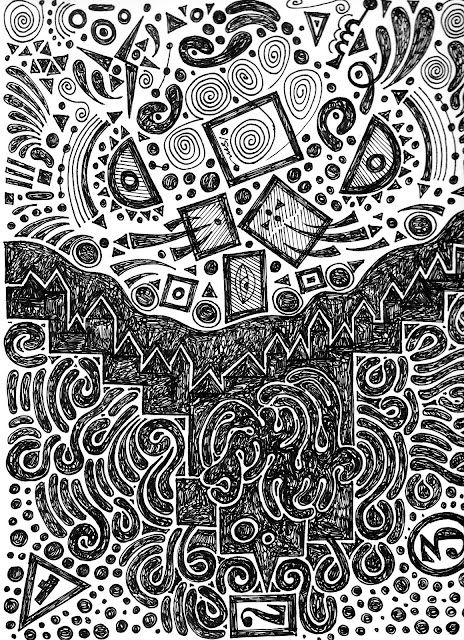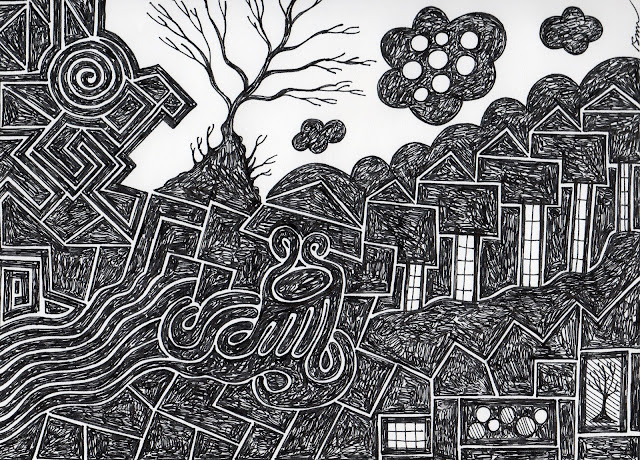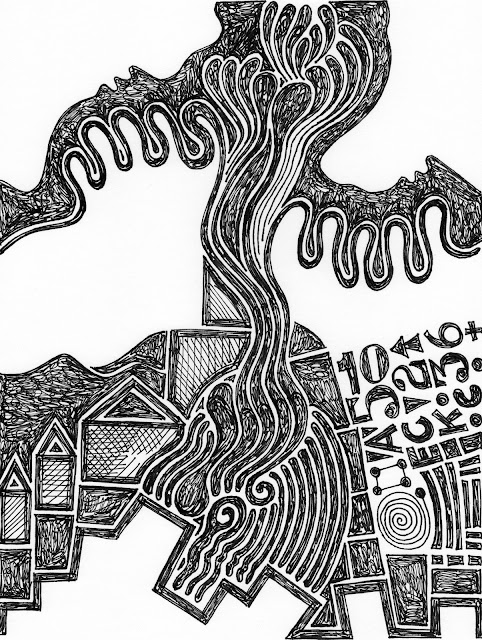This blog is a division of the CODEX ISOM a complete guide to the collected works and writings of Ronald D. Isom, art educator and artist. A study of the heart, soul and mind. Creating esoteric connections to the universe. Without symbols our lives would be as spiritually impoverished as sleep without dreams.
Friday, March 9, 2012
Thursday, March 8, 2012
Wednesday, March 7, 2012
Tuesday, March 6, 2012
Monday, March 5, 2012
Sunday, March 4, 2012
Adinkra symbols, physics and my doodles...
Over the last 50 years I have been creating black and white drawings of personal symbology. I have amassed over 3,000 small drawings and I continue to create 3 or 4 each day and post one daily on my blog. I refer to this collection as the Isom Codex. Part of my process is searching the web and books for some links to my unconscious drawings. Several years ago, I noticed that my titles have some relationship to quantum physics and scientific notation. I have very little education in the area of math and physics. However, I continue to find some connection between my drawings and scientific phenomena, especially physics. My symbols are very much like Adinkra symbols and through my research I found out that physics has some relationship to Adinkra symbols. I realize these relationships are not new discoveries but my unconscious doodles seem to telling me something. The Andinkra symbols are "supporting the transmission of a complex and nuanced body of practice and belief". In my blog, symbols open up and make transparent insights and truths that were previously hidden. I don't know if I will ever find out what all my scribbles on paper mean, but the journey is very exciting.
From Wikipedia, the free encyclopedia
Adinkra symbols recorded by Robert Sutherland Rattray, 1927
This article is about the ancient Akan visual symbols. For the use of the term in theoretical physics, see Adinkra symbols (physics).
Adinkra are visual symbols, originally created by the Akan of Ghana and the Gyaman of Cote d'Ivoire in West Africa, that represent concepts or aphorisms. Adinkra are used extensively in fabrics, pottery, logos and advertising. They are incorporated into walls and other architectural features. Fabric adinkra are often made by woodcut sign writing as well as screen printing. Adinkra symbols appear on some traditional akan gold weights. The symbols are also carved on stools for domestic and ritual use. Tourism has led to new departures in the use of the symbols in such items as T shirts and jewelry.
Calabash adinkra stamps carved in Ntonso, Ghana.
The symbols have a decorative function but also represent objects that encapsulate evocative messages that convey traditional wisdom, aspects of life or the environment. There are many different symbols with distinct meanings, often linked with proverbs. In the words of Anthony Appiah, they were one of the means in a pre-litrate society for "supporting the transmission of a complex and nuanced body of practice and belief".
Saturday, March 3, 2012
Friday, March 2, 2012
Thursday, March 1, 2012
Wednesday, February 29, 2012
Tuesday, February 28, 2012
Monday, February 27, 2012
The answer is always 0...
Copyright 2012 © Ronald D. Isom, Sr.
There are periods of history when the visions of madmen and dope fiends are a better guide to reality than the common-sense interpretation of data available to the so-called normal mind. This is one such period, if you haven't noticed already. Robert Anton Wilson
- The Illuminatus! Trilogy (1975) (with Robert Shea), Part I : The Eye in the Pyramid, p. 32
Sunday, February 26, 2012
Saturday, February 25, 2012
Friday, February 24, 2012
Thursday, February 23, 2012
Wednesday, February 22, 2012
Tuesday, February 21, 2012
Monday, February 20, 2012
Sunday, February 19, 2012
Saturday, February 18, 2012
Friday, February 17, 2012
Thursday, February 16, 2012
Wednesday, February 15, 2012
Tuesday, February 14, 2012
Monday, February 13, 2012
Sunday, February 12, 2012
Saturday, February 11, 2012
Friday, February 10, 2012
Thursday, February 9, 2012
Wednesday, February 8, 2012
Tuesday, February 7, 2012
Monday, February 6, 2012
Sunday, February 5, 2012
Saturday, February 4, 2012
Friday, February 3, 2012
Thursday, February 2, 2012
Wednesday, February 1, 2012
Tuesday, January 31, 2012
Monday, January 30, 2012
Sunday, January 29, 2012
Saturday, January 28, 2012
Friday, January 27, 2012
Thursday, January 26, 2012
Wednesday, January 25, 2012
Tuesday, January 24, 2012
Monday, January 23, 2012
Technocracy...
Knowledge and skill?
Copyright 2012 © Ronald D. Isom, Sr.
Dilbert's presidential bid: is technocracy dressed up as libertarianism the natural political home of the engineer? | openDemocracy:
Copyright 2012 © Ronald D. Isom, Sr.
Technocracy - Wikipedia, the free encyclopedia: "Technocracy is a hypothetical form of government in which science would be in control of all decision making. Scientists, engineers and technologists who have knowledge, expertise or skills would compose the governing body, instead of politicians, businessmen and economists.[1] In a technocracy, decision makers would be selected based upon how knowledgeable and skillful they are in their field."
Sunday, January 22, 2012
Technological singularity...
greater-than-human intelligence
Copyright 2012 © Ronald D. Isom, Sr.
Technological singularity: "hypothetical future emergence of greater-than-human intelligence through technological means, very probably resulting in explosive superintelligence"
Copyright 2012 © Ronald D. Isom, Sr.
"The risks in developing superintelligence include the risk of failure to give it the supergoal of philanthropy. One way in which this could happen is that the creators of the superintelligence decide to build it so that it serves only this select group of humans, rather than humanity in general."
Subscribe to:
Posts (Atom)















































